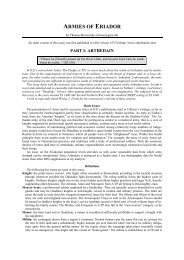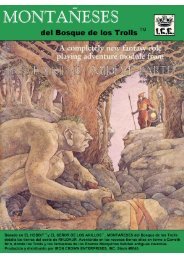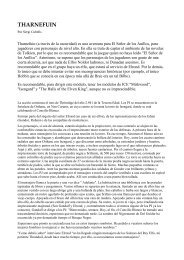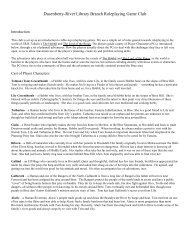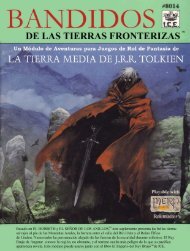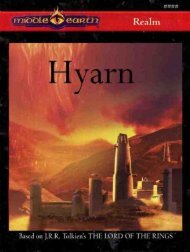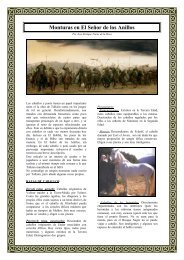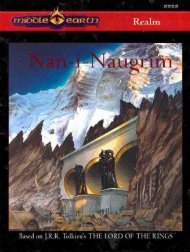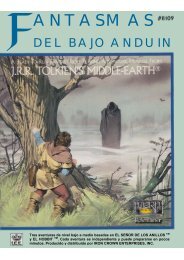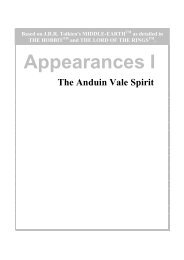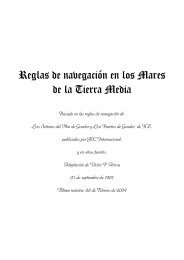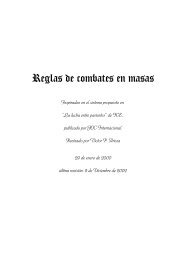Vinyar Tengwar 39 - Fan Modules - Free
Vinyar Tengwar 39 - Fan Modules - Free
Vinyar Tengwar 39 - Fan Modules - Free
Create successful ePaper yourself
Turn your PDF publications into a flip-book with our unique Google optimized e-Paper software.
————————————— <strong>Vinyar</strong> <strong>Tengwar</strong> <strong>39</strong> (July 1998) ———————————<br />
kenta among the Appendices to Quendi and Eldar (MR:415). Christopher<br />
concludes that this complex of material, including the Ósanwe-kenta, “was<br />
thus in being when the newspaper was used for this purpose, and although, as<br />
in other similar cases, this does not provide a perfectly certain terminus ad<br />
quem, there seems to be no reason to doubt that it belongs to 1959-60” (ibid.).<br />
The eight typescript pages presented here appear to comprise the sole extant<br />
text of the Ósanwe-kenta; if it was preceded by any typescript or manuscript<br />
versions, they have apparently not been preserved. In the top margin of the<br />
first of these pages, Tolkien has written the three lines of its present title in<br />
ink. He has also numbered the first seven pages in the upper right-hand corner<br />
by hand, and written the notation “Ósanwe” to the left of the numeral on each<br />
of these pages, also in ink; but the page number and notation are typed in the<br />
same positions on the eighth page. This suggests that Tolkien may have<br />
paused, or perhaps originally concluded the essay, somewhere on the seventh<br />
page, and written the short title and page number on those pages he had typed<br />
at that point, before the eighth page was begun. If so, he may have done so at<br />
the break on the seventh page indicated by a blank space before the paragraph<br />
beginning “If we speak last of the ‘folly’ of Manwë”. The typescript has also<br />
been emended at points by Tolkien in ink, chiefly in correction of<br />
typographical errors, though on a few occasions supplying a change of<br />
wording. Save in a very few instances these changes have been incorporated<br />
silently in this edition.<br />
In this edition, Tolkien’s text has also been reorganized slightly in the<br />
matter of notes. On the first page of the typescript (only) Tolkien used<br />
numbered footnotes, but as throughout Quendi and Eldar, elsewhere in the<br />
Ósanwe-kenta he at points interrupts his text with notes, typically typed on the<br />
line following, or within a few lines of, the notation mark, even where this<br />
interrupts a sentence (cf. WJ:359). Christopher Tolkien’s practice in editing<br />
Quendi and Eldar of collecting Tolkien’s notes at the end of the essay,<br />
distinguishing them from editorial notes by referring to them in the text with<br />
Note 1, Note 2, etc. in parentheses, has been adopted here for most of these<br />
notes. However, seven very brief notes, which simply supply Quenya glosses<br />
of terms under discussion (those for sanwe-latya, sáma, láta, indo, pahta,<br />
avanir, and aquapahtie), have been placed in the main text parenthetically.<br />
A brief editorial glossary of the Elvish forms encountered in the Ósanwekenta<br />
has been supplied following Tolkien’s notes, as a convenient place for<br />
citing further information relevant to them from other texts (especially Quendi<br />
and Eldar, various texts in Morgot’s Ring, and The Etymologies) and for most<br />
of the specifically linguistic editorial commentary.<br />
I am grateful to Christopher Tolkien for providing this text for publication<br />
in <strong>Vinyar</strong> <strong>Tengwar</strong>, and to Christopher Gilson, Wayne Hammond, Christina





